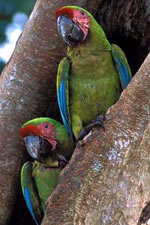On May 9th, Rainforest Biodiversity Group held its 3rd annual spring bird-a-thon to raise funds to support the Costa Rican Bird Route project. This year we had the best turn out to date with 17 birders participating, and 56 people who made pledges to those birders. The total money raised for this year was $2,401.10, exceeding our goal of $2,000. This year we decided to reward our birders with a free t-shirt, as well as give a t-shirt to any donor pledging over $50. As a result, 38 t-shirts were printed and distributed, and we want to give a special thanks to Russ Rothman for helping us purchase the t-shirts.
Of the lists submitted, Daniel Schneider had the most birds seen, turning in an impressive list of 114 species! His number gets better every year, so it will be exciting to see how many he can see next year.
If you have an interest in participating in the Bird-a-Thon in 2010, please send us an email at info@rainforestbiodiversity.org with the subject line: 2010 Bird-a-Thon, and we’ll get you the details you need for next year. Remember, it doesn’t matter where in the world you are, anyone can participate in this bird-a-thon!
Thanks to all who participated and made this event a great success for us and the Bird Route project. The money raised will be used to support our staff efforts in Costa Rica as we continue to work with our sites on becoming sustainable tourism destinations.
Wednesday, July 29, 2009
Thursday, July 9, 2009
Rare Blue Parrot Back from the Brink of Extinction
 The Lear’s Macaw, a striking blue parrot found in northeastern Brazil, has been downlisted from Critically Endangered (the highest threat category) to Endangered as a direct result of conservation action, revealed the 2009 update to the IUCN Red List of Threatened Species.
The Lear’s Macaw, a striking blue parrot found in northeastern Brazil, has been downlisted from Critically Endangered (the highest threat category) to Endangered as a direct result of conservation action, revealed the 2009 update to the IUCN Red List of Threatened Species.(Lear Macaw photo by Paul Salaman)
The current population of Lear’s Macaw is estimated to be 960 birds, up from fewer than 100 birds in 1989. American Bird Conservancy and its Brazilian partner Fundação Biodiversitas have worked to save the macaw’s primary nesting and roosting cliffs, and together have purchased and protected nearly 4,000 acres of habitat to help assure the species’ survival.
“The fight to save Lear’s Macaw is far from over, but the news that it is being downgraded from Critically Endangered to Endangered is a clear indication that hard work is paying off,” said George Fenwick, President of American Bird Conservancy. “The overall picture for birds throughout the Americas and the rest of the world continues to be a great cause for concern, but the macaw serves as a shining example of what we can achieve when focused conservation action is backed up by broad cooperation and the required resources.”
Subscribe to:
Posts (Atom)





